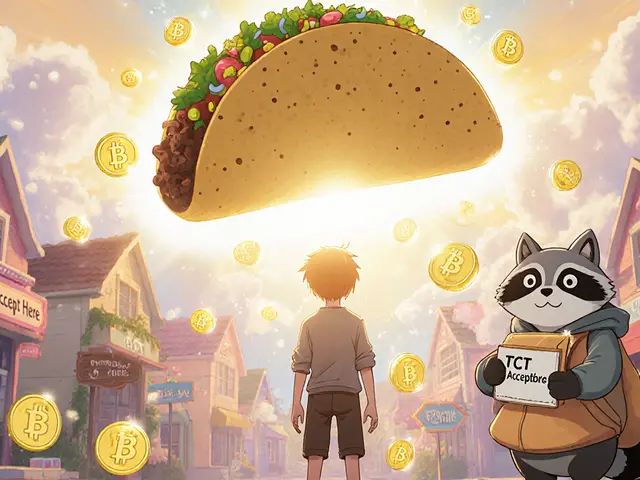Selective Disclosure Privacy Calculator
How much data do you share?
Traditional systems often require sharing more data than necessary. Decentralized identity allows selective disclosure - sharing only what's needed.
Your Privacy Impact
Imagine logging into a website, applying for a loan, or proving you’re over 18 - without ever giving away your name, address, or Social Security number. No more filling out forms. No more uploading scans of your ID. No more worrying about a data breach exposing your personal details. This isn’t science fiction. It’s decentralized identity, and it’s already changing how we prove who we are online.
For years, we’ve handed our personal data to companies - banks, social media platforms, government portals - trusting them to keep it safe. But the numbers don’t lie. In 2023, the average cost of a data breach was $4.45 million, and 80% of those breaches involved stolen identities. Centralized systems are like single points of failure: one hack, and millions of records are exposed. Decentralized identity flips that model. Instead of storing your data in a corporate server, it puts you in control. Your identity lives in your own digital wallet - on your phone or laptop - encrypted and under your command.
How Decentralized Identity Actually Works
At its core, decentralized identity relies on three simple but powerful pieces: Decentralized Identifiers (DIDs), Verifiable Credentials (VCs), and digital wallets.
A DID is a unique string of letters and numbers - like a username you own, not one assigned by a company. It doesn’t contain your name, email, or birthdate. It’s just a key that points to your identity data, which you control. Think of it like a private mailbox number that only you can open.
Verifiable Credentials are digital versions of your real-world documents - your driver’s license, university degree, or vaccination record. But unlike a scanned PDF you email, these are cryptographically signed. If someone tries to alter them, the system knows instantly. The issuer - say, your government or university - signs the credential with their private key. You store it in your wallet. When you need to prove something, you don’t send the whole document. You just show the part you want to share - like proving you’re 21 without revealing your full birthdate or home address.
Digital wallets like Microsoft Entra Verified ID or 1Kosmos BlockID hold these credentials securely. They use your device’s built-in security - fingerprint, face ID, or PIN - to unlock them. No cloud storage. No middleman. Just you and your data.
The backbone? Blockchain or distributed ledger tech. Not Bitcoin, but systems like Sovrin, Hyperledger Indy, or Ethereum. These don’t store your personal info. They just act as a public registry that confirms: yes, this DID belongs to this person, and this credential was issued by this trusted party. It’s like a notary public that never sleeps and never gets hacked.
Why This Is Better Than Passwords and ID Scans
Traditional identity systems are broken. You have dozens of logins. You reuse passwords. You upload your passport to five different apps. And every time you do, you’re adding another target for hackers.
Decentralized identity cuts that risk by 67%, according to Okta’s 2024 research. Why? Because there’s no central database to attack. Your data isn’t on a server. It’s on your phone. Even if a company gets breached, your identity stays safe.
It’s also faster. Microsoft found that once set up, users verify their identity 30% quicker than with traditional two-factor authentication. No more waiting for SMS codes. No more answering security questions you forgot.
And it’s more private. The European Union’s EUDI Wallet lets 447 million citizens prove their identity across borders without sharing unnecessary data. Need to rent a car in Spain? Show your license. Don’t show your tax ID. Need to board a flight? Prove you’re vaccinated. Don’t show your medical history. This is called selective disclosure - and it’s a game-changer.

Who’s Using This Today?
It’s not just startups. Big players are betting big.
Microsoft leads the enterprise market with 28% share, rolling out Entra Verified ID to companies that need secure, compliant identity solutions. IBM and 1Kosmos are close behind. Governments aren’t far behind. The EU is forcing all member states to adopt the EUDI Wallet by September 2026. Canada, Japan, and Australia are piloting similar programs.
In finance, 42% of banks now use decentralized identity for KYC (Know Your Customer) checks. Instead of sending documents back and forth for days, customers can instantly verify their identity with a tap. Fintech startups report cutting onboarding time from five days to under an hour.
Healthcare is another winner. Hospitals use it to match patient records securely across clinics. No more mix-ups. No more lost files. Just a verified credential that says: this is Jane Doe, and here’s her allergy history - only shared with authorized staff.
Even universities are getting in. Some now issue digital diplomas as verifiable credentials. Employers can check if a degree is real - without contacting the school. No more fake resumes.
The Real Problems - And Why It’s Not Everywhere Yet
Decentralized identity isn’t magic. It has real hurdles.
First, recovery. If you lose your phone and didn’t back up your wallet, you might lose your identity. That’s not a hypothetical. Over 40% of early users who lost access had to go through hours of manual verification to get back in. Some still need to visit a government office in person.
Second, interoperability. There are over 50 different DID methods. Not all wallets talk to each other. A credential issued by one system might not work with another. That’s why standards like OID4VCI (coming in early 2025) are so important - they’ll let your digital wallet work with any service that uses verifiable credentials.
Third, user experience. Your grandma shouldn’t need to understand cryptography to prove she’s her own person. Right now, many systems ask users to “sign a message” or “scan a QR code.” That’s confusing. The interface has to be as simple as unlocking your phone - not as complex as setting up a crypto wallet.
And then there’s the fear of tracking. Privacy advocates warn that if issuers embed hidden identifiers in credentials, it could create new ways to track you. GDPR requires data minimization - only collect what you need. If a credential secretly includes your location or device ID, it defeats the whole purpose.

What’s Next? The Road to 2030
The market is exploding. It was worth $1.2 billion in 2022. By 2027, it’s projected to hit $11.8 billion. That’s a 58% annual growth rate.
By 2027, 60% of new digital identity systems will include decentralized elements, according to Okta. That means you’ll see it everywhere: logging into your bank, applying for a job, accessing healthcare, even buying alcohol online.
Integration with AI is coming too. By 2026, 30% of DCI systems will use AI to detect fraud in real time - spotting fake credentials before they’re even used.
But the biggest shift? Control. Right now, companies own your identity. In five years, you will. You’ll choose who sees what, when, and why. You’ll own your data like you own your car or your house.
It’s not about replacing passwords. It’s about replacing the entire model of trust. Instead of trusting corporations to protect your data, you trust cryptography, standards, and your own control.
Should You Care? Yes - Even If You’re Not a Tech Expert
You don’t need to understand blockchain to benefit from decentralized identity. Just like you don’t need to know how electricity works to turn on a light.
What you do need is awareness. When a service asks for your ID, ask: “Can I use a verifiable credential instead?” If they say no, push back. Demand better. The more people ask, the faster companies will adapt.
Start small. If your bank or employer offers a digital wallet for identity, use it. Back up your recovery phrase. Learn how to selectively share data. It’s not just about security - it’s about dignity. Your identity shouldn’t be a product sold to advertisers or stolen by hackers.
The future of identity isn’t centralized. It’s personal. It’s private. And it’s yours.
What is a Decentralized Identifier (DID)?
A Decentralized Identifier (DID) is a unique, user-controlled identifier that doesn’t rely on a central authority like a government or company. It’s a string of characters - like a digital key - that points to your identity data stored securely on your device. Unlike usernames or email addresses, DIDs don’t contain personal information and can’t be taken away by a third party.
How are Verifiable Credentials different from scanned IDs?
Verifiable Credentials are cryptographically signed digital documents that can’t be altered or forged. Unlike a scanned PDF of your driver’s license, which can be copied and misused, VCs include a digital signature from the issuer (like a government or university) that proves authenticity. You can also share only part of the credential - for example, proving you’re over 21 without showing your full name or address.
Can I lose my decentralized identity?
Yes - if you lose your device and don’t have a backup. Unlike passwords, which you can reset through email, decentralized identity relies on cryptographic keys. If you lose your wallet and didn’t save your recovery phrase or use a trusted backup method, you may permanently lose access. That’s why recovery mechanisms are one of the biggest challenges in adoption today.
Is decentralized identity secure?
It’s more secure than centralized systems because there’s no single database to hack. Your data stays on your device, protected by your phone’s biometrics or PIN. But the security shifts from the server to your endpoint. If someone steals your phone and bypasses its lock, they could access your wallet. That’s why strong device security and backup procedures are essential.
Will decentralized identity replace passwords?
Eventually, yes - but not overnight. Passwords are still used everywhere. Decentralized identity won’t replace them overnight, but it’s already replacing them for high-value actions like banking, government services, and enterprise logins. As more services adopt standards like OID4VCI, you’ll see fewer passwords and more seamless, secure logins using your digital wallet.
How do I get started with decentralized identity?
Start by checking if your bank, employer, or government offers a digital identity wallet - like Microsoft Entra Verified ID or a national eID solution. Download the app, follow the setup, and back up your recovery phrase. Then, try using it to log in to a service that supports it. Don’t wait for everything to be perfect - early adoption helps shape the future.







Brian Webb
November 7, 2025 AT 08:59 AMThis is actually one of the most grounded takes on decentralized identity I’ve seen in a while. No hype, no blockchain buzzword bingo. Just clear examples of how it solves real problems - like not having to send your entire birth certificate to rent a bike. I’ve used Microsoft’s wallet for work login and it’s insane how fast it is. No more waiting for SMS codes while stuck in a Zoom call.
Colin Byrne
November 8, 2025 AT 06:15 AMWhile the theoretical framework is elegant, one must consider the structural fragility inherent in placing absolute control in the hands of individuals who, statistically, lack the technical literacy to manage cryptographic keys. The notion that a grandmother can navigate a verifiable credential interface without confusion is a romanticized delusion. The infrastructure may be sound, but the human layer remains catastrophically brittle. We are not building a system for rational agents; we are building one for people who forget their own passwords.
Leo Lanham
November 10, 2025 AT 03:58 AMso you're telling me i have to learn how to 'back up my recovery phrase' just to prove i'm not a robot? bro. i just want to buy weed online without giving my social security number to some sketchy site. this sounds like more work than just using a fake ID.
Whitney Fleras
November 11, 2025 AT 18:49 PMColin makes a great point about the human factor. We can’t ignore that. But we also can’t let perfection be the enemy of progress. The tools are getting simpler - apps are starting to hide the crypto stuff behind fingerprint scans. If we design with empathy, not just tech, this can work for everyone. Start small. Try it with one service. You might be surprised how little you notice the difference - except that you’re safer.
Chloe Walsh
November 12, 2025 AT 16:50 PMthey're selling you a dream while quietly building a new surveillance system. every credential you issue is logged somewhere. who do you think controls the issuers? governments. corporations. they're just replacing one database with another that looks prettier. you think you're in control? you're just the data source now. they'll know you're over 18 before you even open the app. and you'll thank them for it
Stephanie Tolson
November 14, 2025 AT 08:59 AMChloe’s fear is valid - but let’s not throw the baby out with the bathwater. The architecture of decentralized identity is designed to minimize tracking. If issuers embed hidden trackers, that’s a violation of the standards, not a feature. We need to hold them accountable, not reject the whole system. The EU’s EUDI Wallet is built with privacy-by-design. We can demand better. We can build better. But we shouldn’t give up on control because someone might abuse it.
karan thakur
November 16, 2025 AT 00:14 AMThis is a globalist agenda disguised as innovation. Who benefits? The same elites who control the IMF, the WHO, the UN. They want to track every citizen’s movement, spending, and behavior under the guise of 'security.' Your digital wallet will be tied to your tax ID, your voting record, your medical history. Soon you won’t be able to buy a coffee without government approval. This is not freedom. This is digital serfdom.
Vipul dhingra
November 16, 2025 AT 19:23 PMlol you think this is new? we had this in 2016 with self sovereign identity and everyone forgot about it because it was too hard. now they just rebrand it with blockchain and call it magic. same thing different year. also who the hell is going to back up their recovery phrase? people lose their phones every day. this is a disaster waiting to happen
Jacque Hustead
November 18, 2025 AT 09:18 AMEveryone’s got a point here - the tech is powerful, the risks are real, and the UX is still messy. But I’ve seen people who were terrified of crypto wallets learn to use them in 5 minutes because the app looked like their phone’s lock screen. The key isn’t to wait for perfection. It’s to start using it, give feedback, and push for simpler designs. This isn’t about being a tech expert. It’s about saying: I deserve to own my own data. And that’s worth a little learning curve.